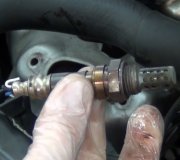So I replaced it. The first time I put a Bosch universal on it, cleared the ECU (both by disconnecting the battery, and removing the fuse), started it up, and immediately the check engine light is back on, reading the same code 21.
Then I returned that one, and got one from a Toyota dealer, put it on, reset the computer, started it up, and the light still is on!
To be sure that the computer is being reset, I removed the throttle position sensor, started it up, read the codes (throttle position sensor and oxygen sensor) turned it off, reset the computer, checked the codes. Sure enough, the TPS code was gone, oxygen sensor code still remained.
Then I checked the wiring. Followed the wires from the oxygen sensor all the way to where they enter the firewall to go to the ECU, tapped into it. Again, no problem, there is continuity between there and the sensor.
So what other options do I have left? Any ideas would help! Thanks so much!
Wednesday, April 4th, 2007 AT 2:31 PM



